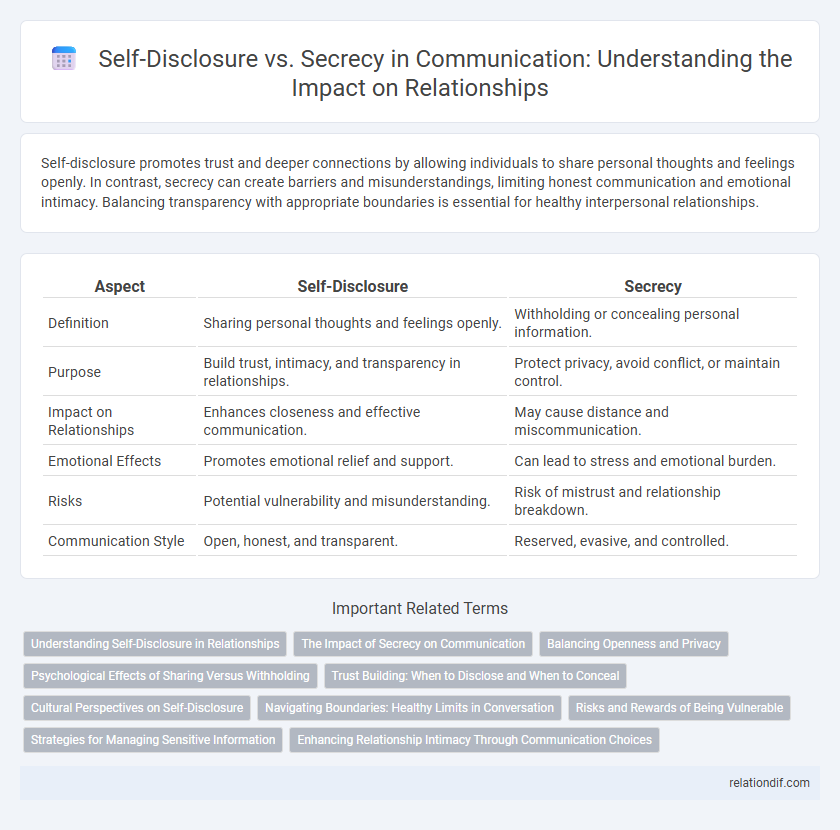Self-disclosure promotes trust and deeper connections by allowing individuals to share personal thoughts and feelings openly. In contrast, secrecy can create barriers and misunderstandings, limiting honest communication and emotional intimacy. Balancing transparency with appropriate boundaries is essential for healthy interpersonal relationships.
Table of Comparison
| Aspect | Self-Disclosure | Secrecy |
|---|---|---|
| Definition | Sharing personal thoughts and feelings openly. | Withholding or concealing personal information. |
| Purpose | Build trust, intimacy, and transparency in relationships. | Protect privacy, avoid conflict, or maintain control. |
| Impact on Relationships | Enhances closeness and effective communication. | May cause distance and miscommunication. |
| Emotional Effects | Promotes emotional relief and support. | Can lead to stress and emotional burden. |
| Risks | Potential vulnerability and misunderstanding. | Risk of mistrust and relationship breakdown. |
| Communication Style | Open, honest, and transparent. | Reserved, evasive, and controlled. |
Understanding Self-Disclosure in Relationships
Understanding self-disclosure in relationships involves recognizing its role in building trust and emotional intimacy by sharing personal thoughts, feelings, and experiences with others. Effective self-disclosure requires balancing openness with privacy to avoid vulnerability while fostering connection. Maintaining appropriate boundaries helps prevent misunderstandings and supports healthy, transparent communication.
The Impact of Secrecy on Communication
Secrecy often creates communication barriers by fostering mistrust and limiting openness between individuals, which can hinder relationship development and conflict resolution. Keeping information concealed may lead to misunderstandings, reduced emotional intimacy, and increased stress for both the secret-holder and the recipient. Research indicates that transparent self-disclosure promotes effective communication, trust-building, and stronger interpersonal connections.
Balancing Openness and Privacy
Balancing openness and privacy in communication requires carefully managing self-disclosure to build trust without compromising personal boundaries. Strategic sharing of thoughts and feelings fosters intimacy while maintaining discretion protects sensitive information. Effective communicators assess context and audience to maintain this dynamic equilibrium between transparency and confidentiality.
Psychological Effects of Sharing Versus Withholding
Sharing personal thoughts and feelings through self-disclosure promotes emotional relief, strengthens trust, and enhances psychological well-being by reducing stress and fostering social support. In contrast, withholding information or maintaining secrecy can increase anxiety, lead to feelings of isolation, and contribute to emotional distress and internal conflict. Research in psychology indicates that balanced self-disclosure correlates with improved mental health outcomes, while excessive secrecy often exacerbates stress and emotional burden.
Trust Building: When to Disclose and When to Conceal
Self-disclosure enhances trust by fostering openness and emotional connection, yet strategic secrecy preserves privacy and protects sensitive information. Assessing the context, relationship depth, and potential consequences guides decisions on when to disclose personal feelings or conceal certain details. Effective communication balances transparency with discretion to build and maintain trust in interpersonal relationships.
Cultural Perspectives on Self-Disclosure
Cultural perspectives on self-disclosure significantly influence communication patterns, as collectivist societies often prioritize group harmony and emphasize secrecy to maintain social cohesion. In contrast, individualistic cultures encourage open self-disclosure as a means of expressing personal identity and fostering authentic interpersonal relationships. Understanding these cultural differences is essential for effective cross-cultural communication and minimizing potential misunderstandings.
Navigating Boundaries: Healthy Limits in Conversation
Navigating boundaries in communication requires a balanced approach to self-disclosure and secrecy, ensuring personal privacy while fostering trust. Establishing healthy limits in conversation protects emotional well-being and strengthens interpersonal relationships by preventing oversharing. Clear boundaries help individuals maintain control over sensitive information and promote respectful, meaningful dialogue.
Risks and Rewards of Being Vulnerable
Self-disclosure in communication fosters trust and deepens relationships but carries risks such as emotional exposure and potential judgment. Vulnerability enables authentic connection and mutual understanding while increasing the likelihood of misunderstandings or breaches of confidentiality. Balancing openness with discretion helps mitigate risks while maximizing the rewards of genuine interpersonal bonds.
Strategies for Managing Sensitive Information
Effective communication strategies for managing sensitive information balance self-disclosure and secrecy by assessing the context, trust level, and potential impact on relationships. Employing selective self-disclosure involves sharing appropriate details that foster trust and intimacy while maintaining necessary boundaries to protect privacy. Utilizing techniques such as gradual revelation and active listening enhances transparency and minimizes risks associated with oversharing or secrecy.
Enhancing Relationship Intimacy Through Communication Choices
Self-disclosure fosters relationship intimacy by encouraging trust and emotional connection, whereas secrecy can create barriers and misunderstandings. Choosing transparent communication allows partners to share vulnerabilities, strengthen empathy, and build deeper bonds. Consistent self-disclosure enhances relational satisfaction, making open dialogue a key factor in long-term intimacy.
self-disclosure vs secrecy Infographic

 relationdif.com
relationdif.com